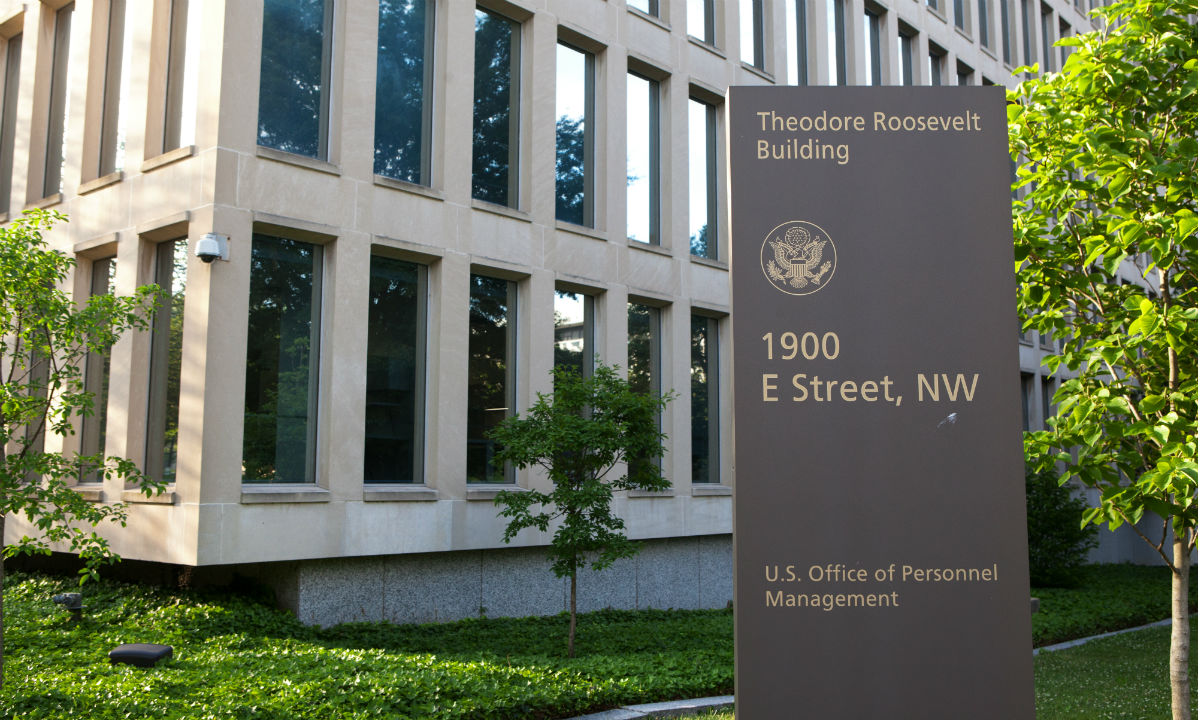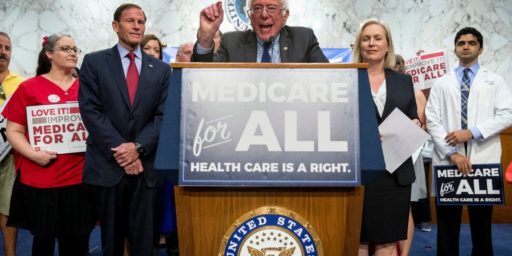Trump Administration Merging OPM into Other Agencies
An odd bureaucratic reshuffling, seemingly out of the blue.

Government Executive (“Trump Administration Outlines How the OPM-GSA Merger Would Work“):
The Trump administration this week provided additional details about how it will implement its proposal to integrate the functions of the Office of Personnel Management into the General Services Administration, Defense Department and the Executive Office of the President, although much remains contingent on Congress approving legislation.
According to a fiscal 2020 budget justification published by GSA, the majority of OPM’s functions will be sent to GSA, making OPM a human capital service alongside GSA’s existing Public Buildings Service and Federal Acquisition Service. Meanwhile, the majority of OPM employees, who work in the National Background Investigations Bureau, will be transferred to the Pentagon, while three employees who work on policy issues will be sent to the Executive Office of the President as an office modeled after the Office of Management and Budget’s Office of Federal Procurement Policy.
Acting OPM Director Margaret Weichert said Wednesday that the changes would take place in two broad phases: this year, functions the White House believes can be done administratively, like HR Solutions and OPM’s IT services, will go to GSA, while remaining offices, such as those that work on retirement and administration of the Federal Employees Health Benefits Program, will have to wait for Congress to pass legislation.
Granting that my main focus is on defense and national security policy, I was somehow completely unaware that this was even on the table. Looking at the above-linked budget justification, I see that:
The 2.1 million-person civilian workforce represents one of the Federal Government’s larger investments and one with great impact. Like any large organization, the Federal Government is only as effective as its people. To address serious shortcomings in the areas of hiring, retention, and performance management, the Executive Branch needs a workforce management structure that elevates personnel strategy and policy, allows for a holistic view of its human capital, and continually optimizes the human resources transactional services necessary to administer one of the largest workforces in the world.
To address long standing workforce management issues, the Administration’s June 2018 Government Reform and Reorganization Plan included a proposal to merge all of OPM’s transactional and consultative services (e.g., those within Human Resources Solutions (HRS), Retirement Services, and Healthcare & Insurance) into GSA. The 2020 President’s Budget reflects the end-state organizational structure and resources necessary to achieve this reorganization of OPM.
I have no strong view on the matter one way or the other but this seems like a thin rationale for a rather major reorganization. Back to the Government Executive report:
The cost of the transition, as requested in the GSA budget, would be $50 million in fiscal 2020. The document also offers some new details about where other OPM functions would wind up in the reorganization, although many questions remain.
An Employee Services office would administer laws and regulations related to recruitment, workforce planning, performance management, pay and leave, as well as programs promoting work-life balance and diversity. A new Health Care and Insurance office would consolidate OPM’s existing health care and insurance responsibilities into one organization, administering FEHBP, Federal Employees’ Group Life Insurance, the Federal Long Term Care Insurance Program, and other health insurance-related programs.
Although the initial reorganization plan was unclear about where OPM’s work to uphold merit systems principles would wind up, the budget justification makes clear it would be part of GSA as the Merit System Accountability and Compliance office.
The budget justification does not outline whether the reorganization would lead to a net job loss at OPM, but it states that 3,315 NBIB employees would be transferred to the Defense Department, while 152 posts at the OPM Office of the Inspector General would be absorbed by the GSA IG’s office.
$50 million is a rounding error in the Federal budget and this may well wind up saving a negligible amount overall. But, again, it’s not obvious to me what problem this is trying to solve.






This administration has made no secret of their desire to dismantle the entire civil service system. This move is likely just a first step that could in some way make that eventual goal easier to accomplish.
As noted in the article, this is mostly about moving the National Background Investigations Bureau into the DoD. Given the Office of Personnel Management data breach involving that specific bureau, this may be a good idea, as the DoD has more experience protecting that sort of information.
@Stormy Dragon: That move I knew about.
Every large company that I have worked for has had random reorganizations that make no real difference anywhere, but are then hailed as a success by someone who was charged with leading that reorganization. There might be a clarification of mission statements.
And then, that guy moves to a different part of the company and does it again to great acclaim.
As much as I want to suspect that everything the Trump administration does is terrible, I actually just suspect that they hired that guy. I mean, they probably hired him out of nepotism, but still, he’s harmless if he just shuffles a few titles around and combines and separates budgets.
Might be Barron’s first role in the administration. What other 13 year old gets to say that he restructured two large government agencies to better meet the needs of their consumers, the American People?
Weird.
I heard about the planned move of the NBIB to the DoD last year, but nothing about the other changes.
There are a host of problems with OPM and the federal bureaucracy in general. Moving pucks on an org chart does nothing to fix them. I don’t see any purpose or use for this move.
When these two agencies with nonoverlapping duties have been merged, the Administration will then declare a large Reduction in Force to eliminate alleged ‘redundancies’ in their workforce.
It’s a combination of “starve the beast” and Trump’s personal animosity toward the “deep state”. Federal civilian employees loathe him; he knows this.
It may be ultimately meaningless desk-shuffling, but being who El Cheeto is and what his party is like, what I’m reminded of is:
One Ring to rule them all,
One ring to find them;
One ring to bring them all
and in the darkness bind them.
Disclosure: I saw the first installment of Jackson’s movie, but have never read the book, nor intend to ever do so.
But that’s a killer good quartet of lines.
Jared Kushner using Whatsapp to discuss nuclear tech with MBS, Netanyahu.
Government reform and reorganization is certainly needed. It should be on-going to fit the needs and situations of a changing society, but should not be done without study and overall planning. There should be an independent committee that can study the bureaucracy from an outsider’s point of view and with a business mind set.*
Efficiency and use of updated technology should be the normal situation. There are probably some agencies are in a time warp when it comes to technology, using manual typewriters and rotary cell phones.
There are many agencies that are repetitive, outdated, and not needed: such as the Tricycle Safety Authority and the Office of Civil War benefits. There are probably many of these agencies that were cranked up long, long ago, and are now unseen and unknown to anyone except the people who work there.
Some agencies are unknown to the Congress and even the president. See NGA. Senator Goldwater once demanded to get into the infamous Hanger 18 at Wright-Patterson AFB. General LeMay, head of the USAF told him where he could go, and it wasn’t Ohio.
*One time at work we had a meeting. The supervisor decided to rearrange the seating and tables so that we would be closer together. We ended up further apart. There is a lesson there somewhere.
The real purpose behind the reorging here is to move personnel policy into the EOP with the mistaken belief that it will allow them more control (they don’t seem to appreciate it is governed by statute).
@DrDaveT: There is no reason to have to CFO offices, to CIO offices, to Congressional Liaison offices, etc. They should be consolidated and redundant admin functions eliminated and they can invest those resources in the mission.
This is another part of the administration’s larger push to consolidate HR, Procurement and facilities into “Enterprise Services” type work groups and activities. The background check folks going to DoD is not surprising, but as others have noted is not likely to solve much. What we will be left with is an existing backlog of security checks that hinder effective hiring, and a hiring action consultation services model that’s been tried across numerous agencies and found wanting. And a couple of administrations hence it will be undone for some other new fangled “more like business” model of work, without the concomitant remembrance of either what failed before, or why making government work “like business” is always going to be folly – hint: Government lacks profit motive and the doers in government (The Executive Branch) don’t control revenue allocation (which rests with Congress)